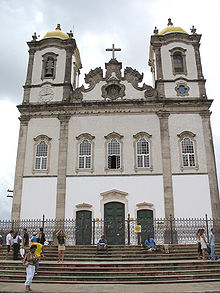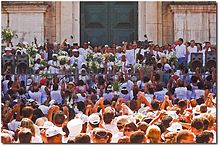- Church of Nosso Senhor do Bonfim, Salvador
-
The Church of Nosso Senhor do Bonfim (Portuguese: Igreja de Nosso Senhor do Bonfim) is the most famous of the Catholic churches of Salvador, in the State of Bahia, Brazil. It was built in the 18th century on a hill in the Itapagipe peninsula, in the lower town of Salvador. The church is the subject of intense religious devotion by the people of Salvador and is the site of a famous celebration held every year in January (Festa do Senhor do Bonfim).
The church is the Cathedral of the Roman Catholic Diocese of Bonfim.
History
The veneration of Nosso Senhor do Bonfim (Our Lord of the Good End, represented by the crucified Jesus in the moment of his death) is an old tradition in Portugal that was imported to Brazil during colonial times. In 1740, in order to fulfill a vow, Portuguese captain Teodósio Rodrigues de Faria brought a statue of Nosso Senhor do Bonfim from Setúbal (Portugal) to Salvador. Some years later a religious brotherhood (irmandade) dedicated to Our Lord of Bonfim was founded and a church to house the statue - the current Church of Nosso Senhor do Bonfim - began being built on top of Montserrat hill, in the Itapagipe peninsula, in the lower town of Salvador. The church was inaugurated in 1754, with the towers being finished around 1772.
The façade of the church is two-dimensional, with a central body flanked by two towers. The windows and specially the elaborate volutes of the gable on top of the façade follow a Rococo (late Baroque) design. The lower parts of the façade were covered by Portuguese white tiles (azulejos) in 1873.
The inner decoration of the church was only finished in the 19th century. The Neoclassical main altarpiece, which has the form of a baldachin with a cupola sustained by volutes, was carved and probably also designed by sculptor Antônio Joaquim dos Santos between 1813 and 1814. The lateral walls of the single-aisled nave are decorated with several altarpieces.
Another notable feature of the church is the painted wooden ceiling, executed by Bahia artist Franco Velasco between 1818 and 1820, which shows people thanking Our Lord of Bonfim for having survived a shipwreck. The sacristy, nave and other rooms of the church display paintings by another notable Bahia painter, José Teófilo de Jesus, executed in the 1830s.
In the 19th century, the Bonfim Brotherhood built houses in the square in front of the church to house the pilgrims (romeiros) that come to Salvador every year to honour Our Lord of Bonfim.
Festa do Bonfim
The Festa do Bonfim (Feast of Bonfim) is one of the most important annual popular celebrations in Salvador, starting on the second Thursday after Three Kings Day (January 6). On this Thursday, the faithful gather in front of the Church of Conceição da Praia, in downtown Salvador (Baixa), including a large group of Bahia ladies (bahianas) in traditional white costume, with turbants and long, round skirts. After mass, the faithful take part on a procession that leaves the Church of Conceição da Praia and, after an 8-km course, reaches the hill of the Bonfim Church. Upon reaching the top, the bahianas wash the steps and the square (adro) in front of the church with aromatised water while dancing and singing chants in Yoruba language. The washing ritual is called the Lavagem do Bonfim (Washing of Bonfim) and attracts a multitude of believers as well as tourists.
The celebrations last ten days and end with a massive mass in the Bonfim Church. Many worshippers come from far away to honour vows taken with Our Lord of Bonfim. The church has a museum of ex-votos brought by the worshippers in gratitude after receiving a divine grace. The feast includes stands serving traditional food, souvenirs, traditional dances and concerts by local musical groups.
Even though the feast is Catholic in its origins, it also reveals much about the religious syncretism between Catholicism and African religions in Bahia. In the Candomblé religion, Our Lord of Bonfim is associated with Oxalá, father of the Orishas and creator of humankind. Indeed, people dress in white during the feast to honour Oxalá.
References
Categories:- Roman Catholic churches in Brazil
- Salvador
- Basilica churches in South America
- 18th-century church buildings
Wikimedia Foundation. 2010.



